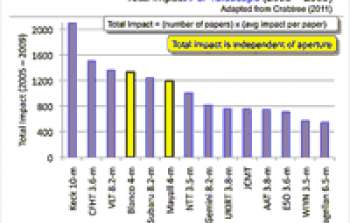sci11007 — Announcement
Dire Budget Projections from NSF AST: Your Input Needed (Continued)
October 31, 2011
The last issue of Currents described the dire budget projections from NSF MPS Astronomy (AST) and the possibility of drastic changes that would alter the landscape of ground-based astronomy. Because such changes require careful planning and consultation with the community, we created a website to enable community discussion on how we can best meet the budgetary challenges.
What We Heard
Many people have discussed the importance of NOAO facilities and programs to their research and education programs and the science that is at stake if NOAO facilities are closed. Other comments address funding priorities more generally, describing the need for a balanced, cost-efficient set of facilities that are the engines of discovery and enable a robust individual investigator program. Here are some of the common themes that have been discussed, with excerpts from the comments received thus far.
Discovery in astronomy: “There are many more astronomy puzzles than astronomers” and therefore astronomy is “rapidly expanded by small teams or individuals working on many interdependent problems simultaneously.” This calls for “a balanced distribution of large, medium, and small” aperture facilities to enable future discovery. The NOAO 4-m telescopes will remain powerful “engines of discovery” into the future, e.g., “the BigBOSS spectrograph will make the Mayall the best facility in the world for wide-field spectroscopy”.
A robust (and diverse) individual investigator program: Open access through NOAO facilities is an important way to enable the “robust individual investigator program” and “diverse scientific workforce” that is a priority for the NSF. An open access system keeps us on our toes: “Because each run, each visit has to be earned by competition and review, we’ve kept our science sharp. Equally important, the diversity of scientists using and being trained at these facilities has been preserved.” Diversity is further tied to discovery: “We need to continue to provide national facilities and equal access for anyone with a great idea to execute that idea.”
Training the next generation of astronomers: Several people describe the impact of potential facility closures on the ability of the community to train the next generation of astronomers. An open access system is valuable because it “allows students to experience the scientific process from end-to-end, i.e., to conceive their own projects, compete for observing time, and carry out the project.” Others note the value of training students through hands-on observing experiences that are not available through queue-scheduled facilities.
Cost efficiency in our age of austerity: Many are concerned that the closure of NOAO facilities would deprive the community of some of its most cost efficient facilities. Pointing to the very high science-per-dollar ratio of the 4-m telescopes, people find “the cost effectiveness and productivity of the 4-m systems…well suited to our current age of austerity.” They also find that being able to “work on myriad unanswered questions with 4-m telescopes on the front lines without spending billions of dollars…is an appealing…back-to-basics approach that would enable the community to weather the budget crisis” while producing strong, potentially ground-breaking science.
It is also pointed out that NSF support for CTIO and KPNO is leveraged to produce a wide array of community science, because these sites host facilities operated by other consortia (e.g., SMARTS, WIYN, SOAR, the Bok telescope, Spacewatch, MDM, SARA, PROMPT, WHAM, ALO, and soon LCOGTN).
Astro2010 and the NSF/AST Portfolio Review: Calling for careful planning, people note that although the Astro2010 priorities were based on optimistic budget scenarios, the declining budget situation we face requires “a careful look at all options.” Many encourage the NSF and the Portfolio Review committee to compare the scientific productivity of all facilities and programs under review because “the dire budget scenario requires an honest look at all programs.” Expressing a view of the future held by others, one person commented, “This is an era of lean budgets that extends into the foreseeable future,” and as a result “we may not realize most of the Astro2010 recommendations in our careers…We need to maintain the necessary core capabilities and the broad health of the astronomy community. Perhaps progress on key questions will be slower than we wish, but the field needs to be positioned to capitalize when times are better.”
The website remains open for further discussion. Read what others have said…and add your voice! Importantly, even if you find that others have already expressed your views, please write in to let us know that. Comments received will be made available to the NSF/AST Portfolio Review Committee.
About the Announcement
| Id: |
ID
sci11007
|
